Abstract
Protection against Escherichia coli inoculated intraperitoneally into mice was enhanced by intraperitoneal, intravenous, or subcutaneous administration of a water-soluble, high-molecular-weight fraction extracted from a dialyzed hot-water extract from a strain of Chlorella vulgaris (CVE-A). The enhancing effect was detected with doses over 2.0 mg/kg and when doses were administered 1, 4, or 7 days before the infection. The elimination of bacteria from the spleen of CVE-A-treated mice was increased, and this enhanced elimination may have been related to the acceleration of superoxide generation and chemokinesis in polymorphonuclear leucocytes by CVE-A treatment. A cyclophosphamide-induced decrease in protection against E. coli could be prevented by subcutaneous administration of CVE-A.
Full text
PDF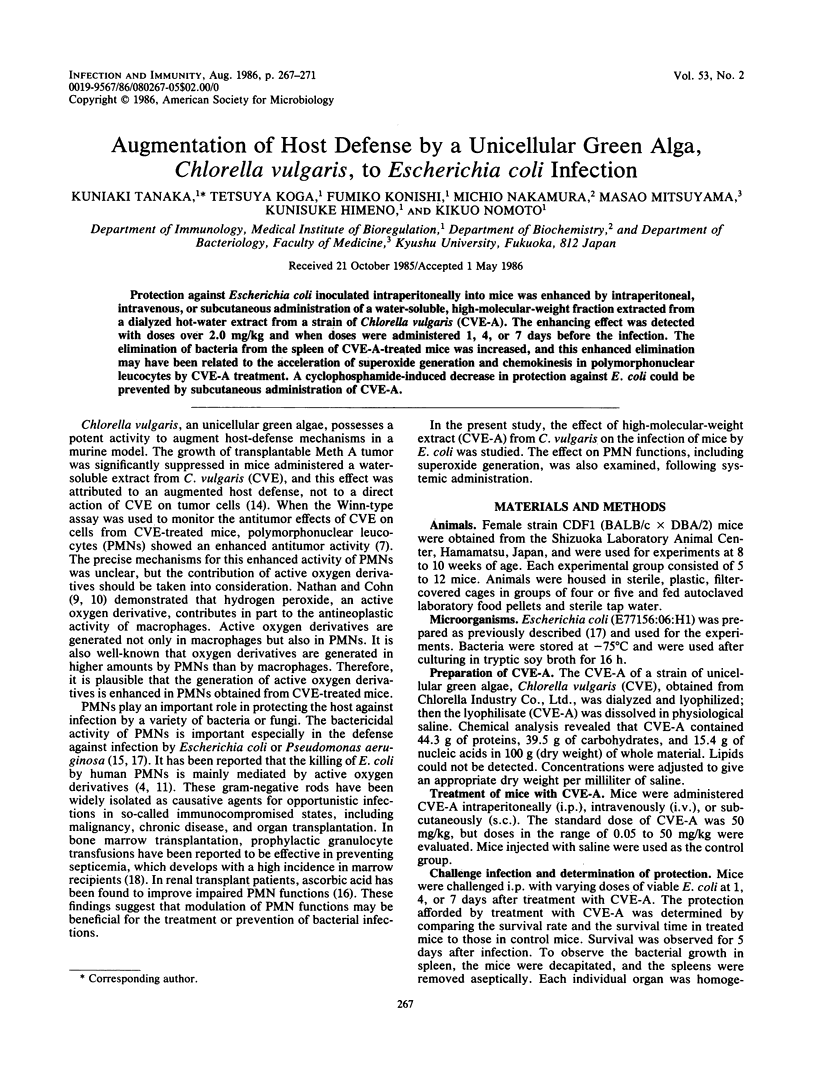
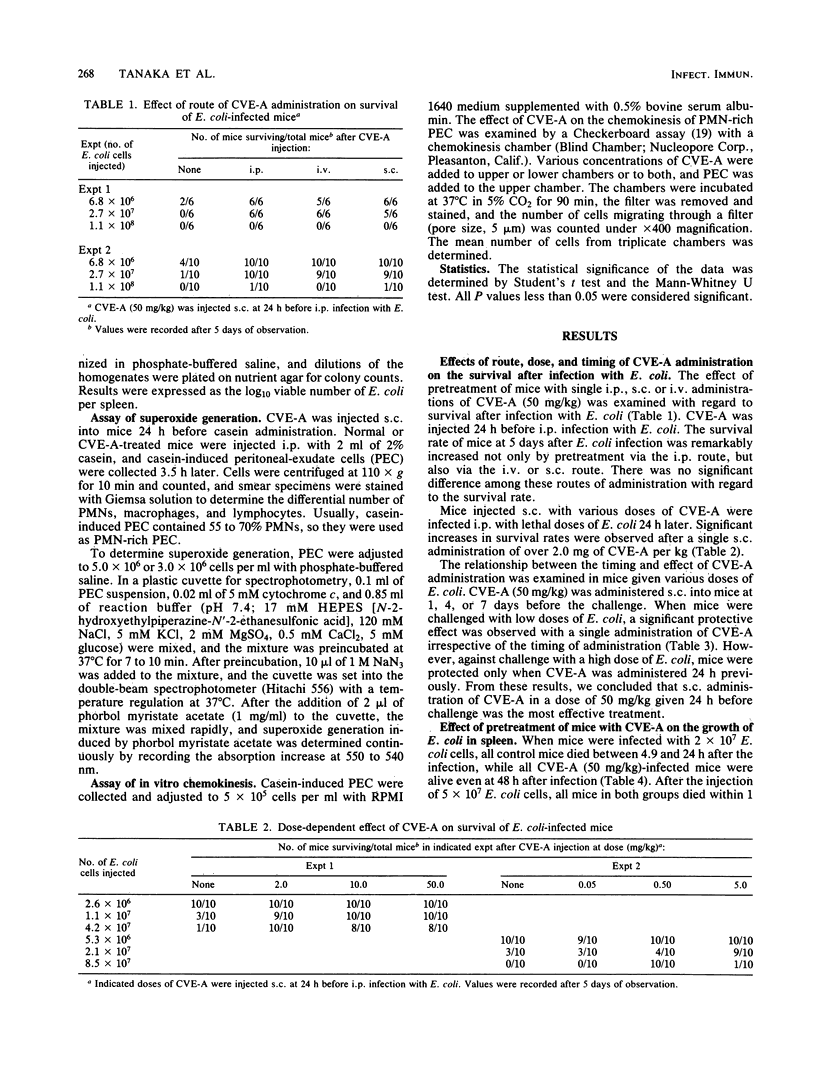
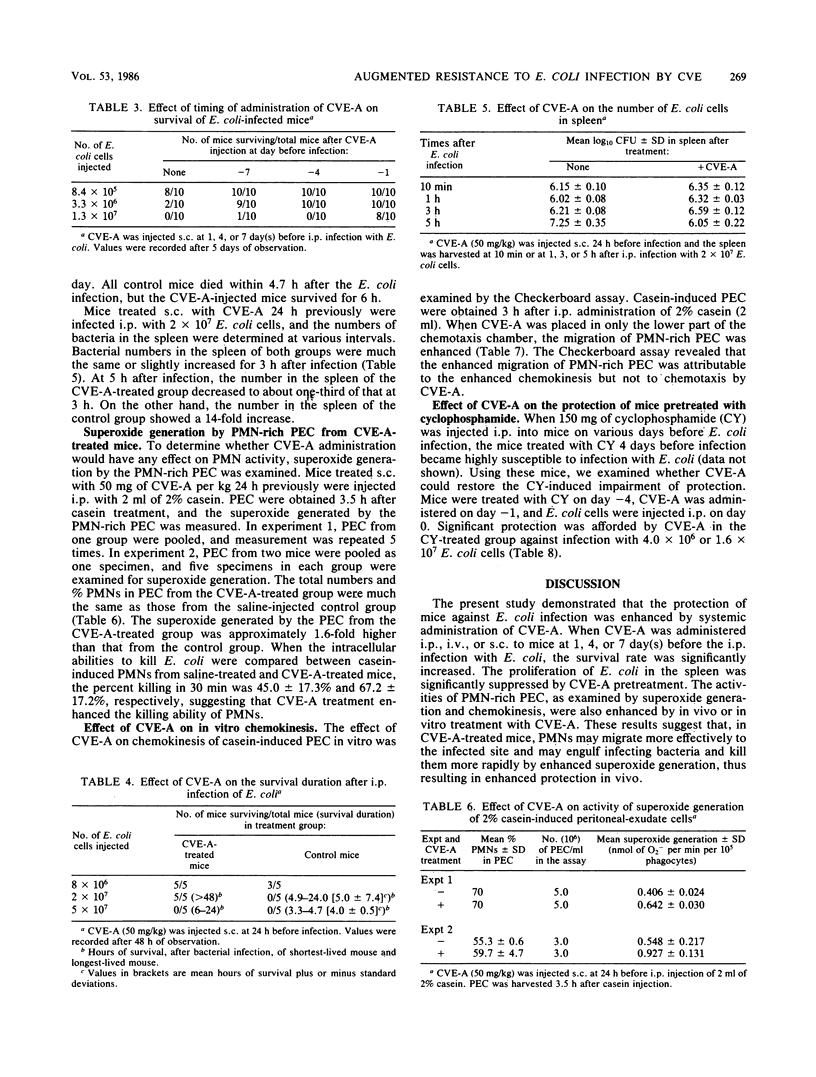
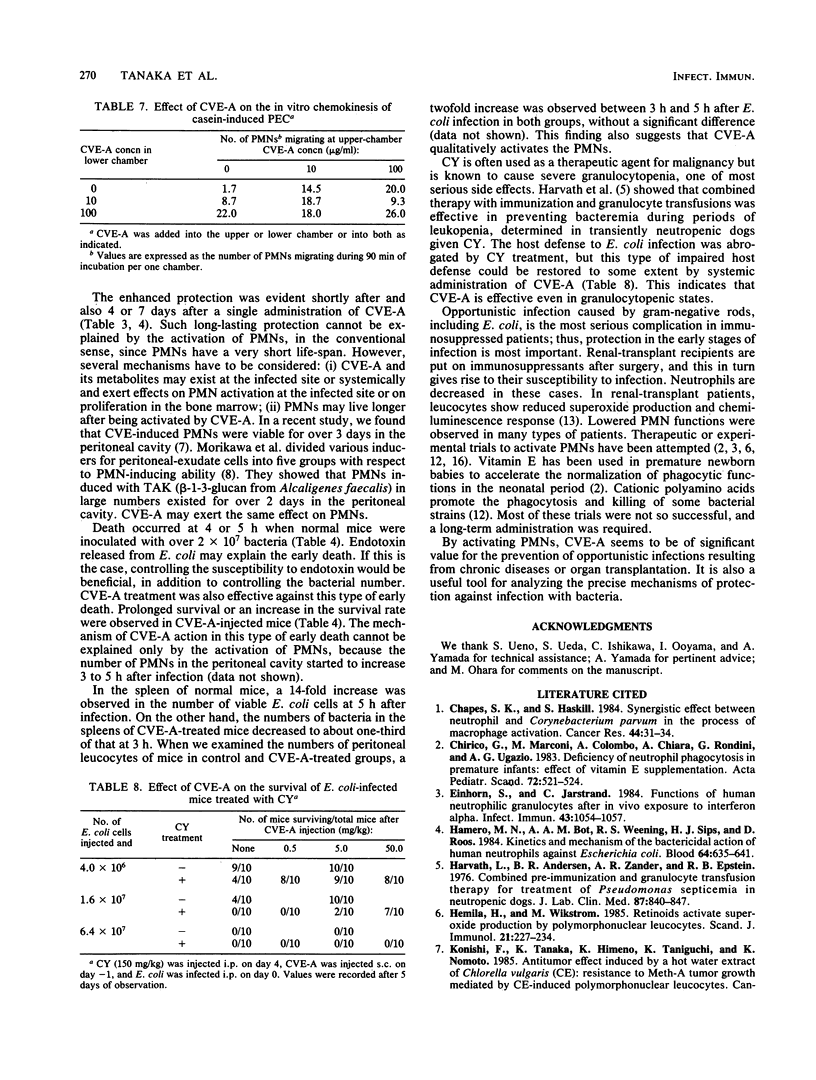
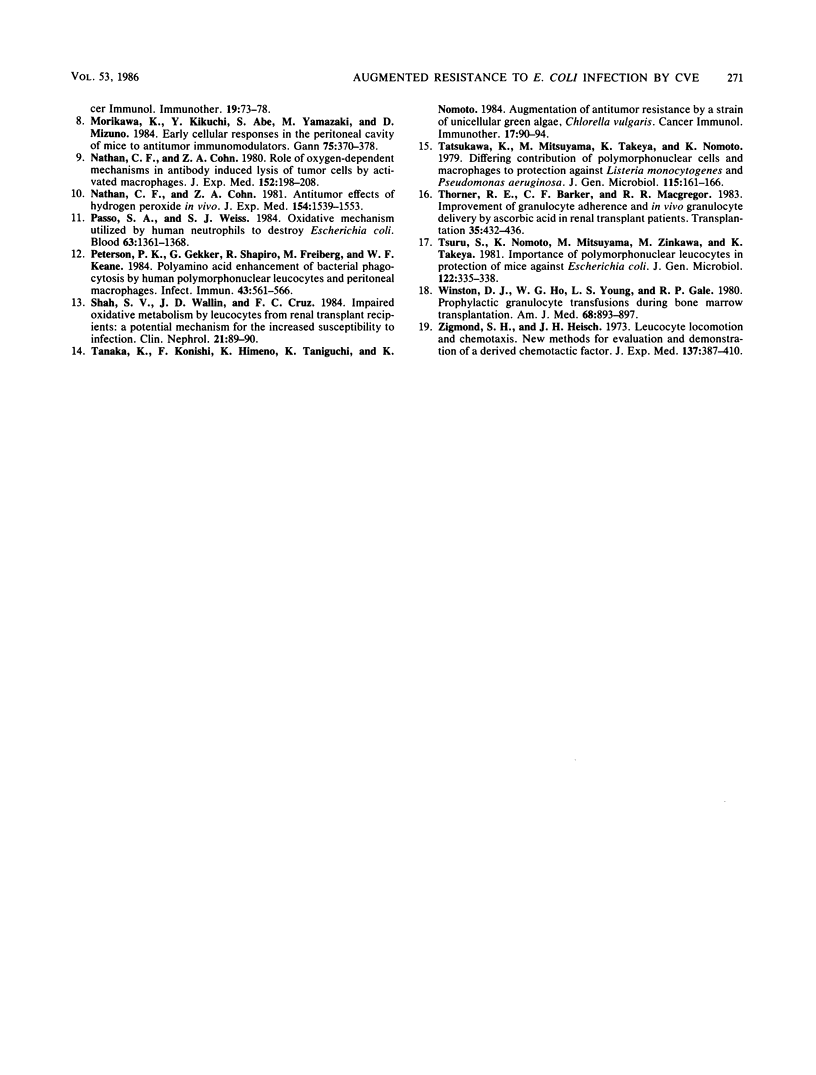
Selected References
These references are in PubMed. This may not be the complete list of references from this article.
- Chapes S. K., Haskill S. Synergistic effect between neutrophils and Corynebacterium parvum in the process of macrophage activation. Cancer Res. 1984 Jan;44(1):31–34. [PubMed] [Google Scholar]
- Chirico G., Marconi M., Colombo A., Chiara A., Rondini G., Ugazio A. G. Deficiency of neutrophil phagocytosis in premature infants: effect of vitamin E supplementation. Acta Paediatr Scand. 1983 Jul;72(4):521–524. doi: 10.1111/j.1651-2227.1983.tb09764.x. [DOI] [PubMed] [Google Scholar]
- Einhorn S., Jarstrand C. Functions of human neutrophilic granulocytes after in vivo exposure to interferon alpha. Infect Immun. 1984 Mar;43(3):1054–1057. doi: 10.1128/iai.43.3.1054-1057.1984. [DOI] [PMC free article] [PubMed] [Google Scholar]
- Hamers M. N., Bot A. A., Weening R. S., Sips H. J., Roos D. Kinetics and mechanism of the bactericidal action of human neutrophils against Escherichia coli. Blood. 1984 Sep;64(3):635–641. [PubMed] [Google Scholar]
- Harvath L., Andersen B. R., Zander A. R., Epstein R. B. Combined pre-immunization and granulocyte transfusion therapy for treatment of pseudomonas septicemia in neutropenic dogs. J Lab Clin Med. 1976 May;87(5):840–847. [PubMed] [Google Scholar]
- Hemilä H., Wikström M. Retinoids activate superoxide production by polymorphonuclear leucocytes. Scand J Immunol. 1985 Mar;21(3):227–234. doi: 10.1111/j.1365-3083.1985.tb01425.x. [DOI] [PubMed] [Google Scholar]
- Konishi F., Tanaka K., Himeno K., Taniguchi K., Nomoto K. Antitumor effect induced by a hot water extract of Chlorella vulgaris (CE): resistance to Meth-A tumor growth mediated by CE-induced polymorphonuclear leukocytes. Cancer Immunol Immunother. 1985;19(2):73–78. doi: 10.1007/BF00199712. [DOI] [PMC free article] [PubMed] [Google Scholar]
- Morikawa K., Kikuchi Y., Abe S., Yamazaki M., Mizuno D. Early cellular responses in the peritoneal cavity of mice to antitumor immunomodulators. Gan. 1984 Apr;75(4):370–378. [PubMed] [Google Scholar]
- Nathan C. F., Cohn Z. A. Antitumor effects of hydrogen peroxide in vivo. J Exp Med. 1981 Nov 1;154(5):1539–1553. doi: 10.1084/jem.154.5.1539. [DOI] [PMC free article] [PubMed] [Google Scholar]
- Nathan C., Cohn Z. Role of oxygen-dependent mechanisms in antibody-induced lysis of tumor cells by activated macrophages. J Exp Med. 1980 Jul 1;152(1):198–208. doi: 10.1084/jem.152.1.198. [DOI] [PMC free article] [PubMed] [Google Scholar]
- Passo S. A., Weiss S. J. Oxidative mechanisms utilized by human neutrophils to destroy Escherichia coli. Blood. 1984 Jun;63(6):1361–1368. [PubMed] [Google Scholar]
- Peterson P. K., Gekker G., Shapiro R., Freiberg M., Keane W. F. Polyamino acid enhancement of bacterial phagocytosis by human polymorphonuclear leukocytes and peritoneal macrophages. Infect Immun. 1984 Feb;43(2):561–566. doi: 10.1128/iai.43.2.561-566.1984. [DOI] [PMC free article] [PubMed] [Google Scholar]
- Shah S. V., Wallin J. D., Cruz F. C. Impaired oxidative metabolism by leukocytes from renal transplant recipients: a potential mechanism for the increased susceptibility to infection. Clin Nephrol. 1984 Feb;21(2):89-90, 91-2. [PubMed] [Google Scholar]
- Tanaka K., Konishi F., Himeno K., Taniguchi K., Nomoto K. Augmentation of antitumor resistance by a strain of unicellular green algae, Chlorella vulgaris. Cancer Immunol Immunother. 1984;17(2):90–94. doi: 10.1007/BF00200042. [DOI] [PMC free article] [PubMed] [Google Scholar]
- Tatsukawa K., Mitsuyama M., Takeya K., Nomoto K. Differing contribution of polymorphonuclear cells and macrophages to protection of mice against Listeria monocytogenes and Pseudomonas aeruginosa. J Gen Microbiol. 1979 Nov;115(1):161–166. doi: 10.1099/00221287-115-1-161. [DOI] [PubMed] [Google Scholar]
- Thorner R. E., Barker C. F., MacGregor R. R. Improvement of granulocyte adherence and in vivo granulocyte delivery by ascorbic acid in renal transplant patients. Transplantation. 1983 May;35(5):432–436. doi: 10.1097/00007890-198305000-00008. [DOI] [PubMed] [Google Scholar]
- Tsuru S., Nomoto K., Mitsuyama M., Zinnaka Y., Takeya K. Importance of polymorphonuclear leucocytes in protection of mice against Escherichia coli. J Gen Microbiol. 1981 Feb;122(2):335–338. doi: 10.1099/00221287-122-2-335. [DOI] [PubMed] [Google Scholar]
- Winston D. J., Ho W. G., Young L. S., Gale R. P. Prophylactic granulocyte transfusions during human bone marrow transplantation. Am J Med. 1980 Jun;68(6):893–897. doi: 10.1016/0002-9343(80)90223-5. [DOI] [PubMed] [Google Scholar]
- Zigmond S. H., Hirsch J. G. Leukocyte locomotion and chemotaxis. New methods for evaluation, and demonstration of a cell-derived chemotactic factor. J Exp Med. 1973 Feb 1;137(2):387–410. doi: 10.1084/jem.137.2.387. [DOI] [PMC free article] [PubMed] [Google Scholar]


